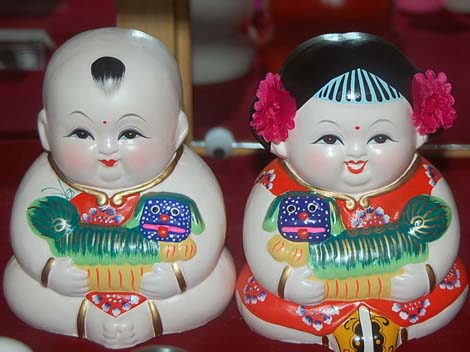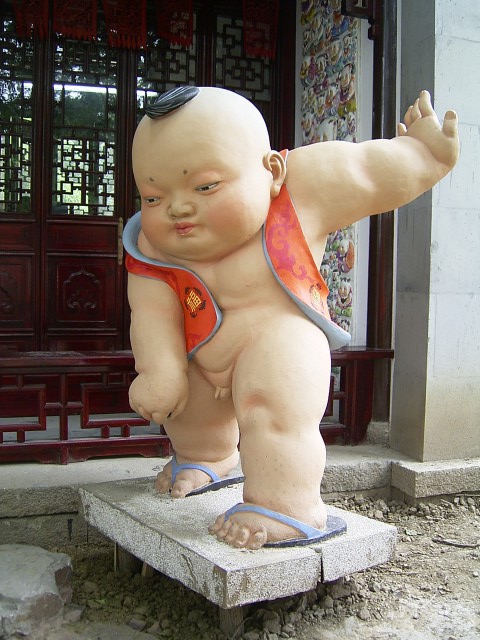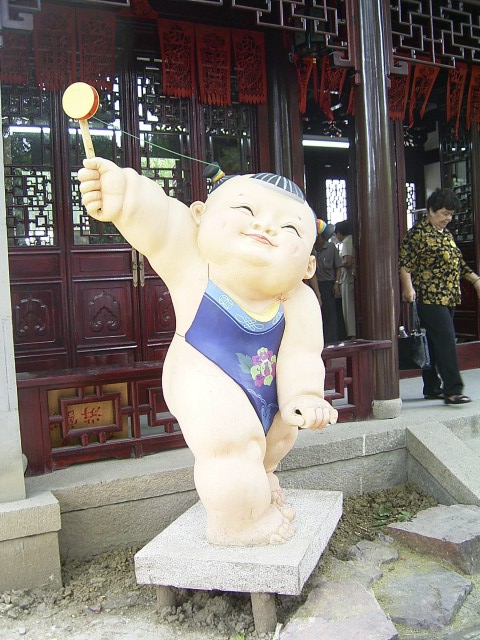
Clay figurines are Wuxi's most famous folk craft. The techniques for making and decorating the figurines developed among the ordinary people of the area of many centuries, and these traditional styles and techniques are still used today. The themes and decoration of the small statues make them a charming example of traditional Chinese folk culture. Connoisseurs classify the figurines into two main types - simple and fine. The two styles differ in their shape, decoration, production, and also history. Perhaps most interesting to foreign tourists are the "simple" figurines, which are the most traditional and have a distinctive folk style and are steeped in many local customs and traditions. They are first shaped with a simple mold, and artisans add specific details by hand. They are decorated with the symbols of good luck, prosperity, and happiness that were popular among the peasants and ordinary people of Jiangsu in past centuries. In keeping with their folk style, they are decorated in bright, lively colors like green, blue, and yellow, and their shape and expressions are very stylized. Fine figurines are more realistic and finely worked and rely less on folk traditions and styles. Some of the most popular motifs for fine figurines drawn from Chinese myths and legends, characters in classical operas, beautiful women, and playing children. While these subjects have remained popular over the centuries, other themes have fallen in and out of fashion with the times, like the heroic workers and peasants which were popular in the 1960's. They pay great attention to creating realistic looking clothing, especially on the lavish and elaborate outfits of Chinese opera characters. The main styles of traditional figurines are animals and chubby babies. While the figurines themselves are beautiful, they are especially interesting because of their rich background in traditional Chinese folklore. The most common figurines are of chubby babies, with outsized heads and wide smiles, sitting crossed legged. Having children has traditionally been one of the most prized things in Chinese life, due both to Confucian traditions that stress carrying on the family line and the more practical desire of peasants to have extra hands around the farm. The baby figurines were especially popular due to these beliefs, and they are always depicted rather pudgy, with rosy cheeks and bright eyes to show their good health. The babies are always shown holding plants, animals, or household objects with allegorical meanings promising heath, wealth, or happiness. often based on nearly untranslatable Chinese language puns and homophones. The classic chubby baby figure is the Da Ah Fu, which has become something of a symbol for Wuxi itself. The Da Ah Fu figurine is always shown with five allegorical symbols, representing a range of wishes. In its hair it wears a peony flower, a symbol of status and prosperity (still used today on the back of the 1 RMB coin). Its clothes are decorated in five colors to represent wealth, and hanging from its neck is a lock which represents long life. The Da Ah Fu's toy green maned lion is a also charm to ward off evil spirits. The symbolism extends to the tips of its toes - it wears white soled shoes representing success in the imperial examinations. Cats are perhaps the most classic type of animal figurines. Hardly cute kittens, they are crafted to look almost fierce, traditionally with long droopy whiskers made of silk. Their popularity and somewhat imposing demeanor stem from the importance of silk in rural Jiangsu. The silk worms are an easy snack for mice as they spin the cocoons that are later used to make silk. Peasants traditional kept cats to scare away, or better yet, eat the pesky mice. The cat figurines were both a good luck charm against mice, and also a reminder of the prosperity that came from a successful silk harvest. The two other traditional animals, the "spring ox" and a large rooster, also reflect China's peasant traditions.


Clay figurines are Wuxi's most famous folk craft. The techniques for making and decorating the figurines developed among the ordinary people of the area of many centuries, and these traditional styles and techniques are still used today. The themes and decoration of the small statues make them a charming example of traditional Chinese folk culture.
Connoisseurs classify the figurines into two main types - simple and fine. The two styles differ in their shape, decoration, production, and also history. Perhaps most interesting to foreign tourists are the "simple" figurines, which are the most traditional and have a distinctive folk style and are steeped in many local customs and traditions. They are first shaped with a simple mold, and artisans add specific details by hand. They are decorated with the symbols of good luck, prosperity, and happiness that were popular among the peasants and ordinary people of Jiangsu in past centuries. In keeping with their folk style, they are decorated in bright, lively colors like green, blue, and yellow, and their shape and expressions are very stylized. Fine figurines are more realistic and finely worked and rely less on folk traditions and styles. Some of the most popular motifs for fine figurines drawn from Chinese myths and legends, characters in classical operas, beautiful women, and playing children. While these subjects have remained popular over the centuries, other themes have fallen in and out of fashion with the times, like the heroic workers and peasants which were popular in the 1960's. They pay great attention to creating realistic looking clothing, especially on the lavish and elaborate outfits of Chinese opera characters.

The main styles of traditional figurines are animals and chubby babies. While the figurines themselves are beautiful, they are especially interesting because of their rich background in traditional Chinese folklore. The most common figurines are of chubby babies, with outsized heads and wide smiles, sitting crossed legged. Having children has traditionally been one of the most prized things in Chinese life, due both to Confucian traditions that stress carrying on the family line and the more practical desire of peasants to have extra hands around the farm. The baby figurines were especially popular due to these beliefs, and they are always depicted rather pudgy, with rosy cheeks and bright eyes to show their good health. The babies are always shown holding plants, animals, or household objects with allegorical meanings promising heath, wealth, or happiness. often based on nearly untranslatable Chinese language puns and homophones.
The classic chubby baby figure is the Da Ah Fu, which has become something of a symbol for Wuxi itself. The Da Ah Fu figurine is always shown with five allegorical symbols, representing a range of wishes. In its hair it wears a peony flower, a symbol of status and prosperity (still used today on the back of the 1 RMB coin). Its clothes are decorated in five colors to represent wealth, and hanging from its neck is a lock which represents long life. The Da Ah Fu's toy green maned lion is a also charm to ward off evil spirits. The symbolism extends to the tips of its toes - it wears white soled shoes representing success in the imperial examinations.
Cats are perhaps the most classic type of animal figurines. Hardly cute kittens, they are crafted to look almost fierce, traditionally with long droopy whiskers made of silk. Their popularity and somewhat imposing demeanor stem from the importance of silk in rural Jiangsu. The silk worms are an easy snack for mice as they spin the cocoons that are later used to make silk. Peasants traditional kept cats to scare away, or better yet, eat the pesky mice. The cat figurines were both a good luck charm against mice, and also a reminder of the prosperity that came from a successful silk harvest. The two other traditional animals, the "spring ox" and a large rooster, also reflect China's peasant traditions.





